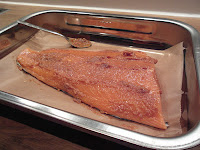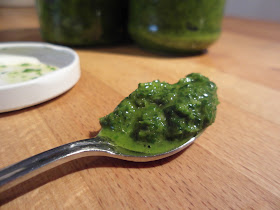 These apple turnovers were the third part of our three-course dinner from last night.
These apple turnovers were the third part of our three-course dinner from last night.Local apples are starting to come into season now, and I have seen lots of different varieties at the markets.
I had a hankering for some apples and pastry, so decided on a simple apple turnover. All I had to buy was the fresh apples; everything else was in the fridge and pantry.
I made my own apples for the filling, as it is difficult to find tinned pie apples here, but you could easily use tinned apples and add the rum and walnuts to get the same effect.
I would have added some cinnamon to this recipe, but I didn't have any. I will include it in the recipe though, as I think it would be better with it. I did add a little fresh rosemary, which probably sounds a bit strange, but it works well; try it.
What you'll need
* Makes four apple turnovers.3 large cooking apples, peeled, cored and roughly chopped into cubes - I used Golden Delicious variety
 1 tbs rum
1 tbs rum2 tbs brown sugar
20g butter, plus a little extra melted butter for brushing
1/2 tsp fresh rosemary, finely chopped
1/4 cup water
1/4 tsp ground cinnamon
1/4 walnuts, roughly chopped
8 pieces of puff pastry, approx 10 x 10cm
What to do
 Melt the butter in a pan over medium heat. Once melted, add the apples and saute for a few minutes. Add the sugar, rum and rosemary, stir well, then add the water.
Melt the butter in a pan over medium heat. Once melted, add the apples and saute for a few minutes. Add the sugar, rum and rosemary, stir well, then add the water.Reduce the heat to low and simmer until the apples are tender (but not falling apart). Set aside to cool.
 Preheat the oven to 180 degrees Celsius.
Preheat the oven to 180 degrees Celsius.On a lined baking tray, set out four pieces of the pastry, spoon approx 2 tbs of the apple mixture into the middle of each pastry square.
Leave 2cm of pastry free around the edge to seal with with the lid.
Sprinkle the walnuts evenly over each pastry square. Then put the lids on each.
Place the pastry evenly over the top of the apples, and then squish down around the edge with a fork, so that the two pieces of pastry join together.
 Prick the top of each turnover with a fork. Brush each with melted butter to help it brown and crisp. You can also sprinkle a little sugar over the top if you like. I sprinkled a little brown sugar, which melted nicely.
Prick the top of each turnover with a fork. Brush each with melted butter to help it brown and crisp. You can also sprinkle a little sugar over the top if you like. I sprinkled a little brown sugar, which melted nicely.Bake in the oven for 20 to 25 minutes, turning the tray around once during cooking to make sure the turnovers brown evenly. The turnovers are ready when the pasty is puffed and brown.
Let rest for five minutes, then served while still warm with cream or vanilla icecream. These turnovers were really yummy; the flaky pastry, melted icecream and warm, spicy apples. This is my idea of a simple but satisfying dessert.













































